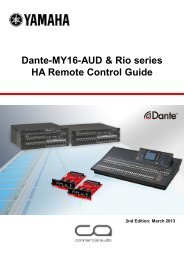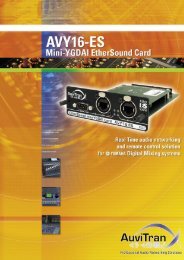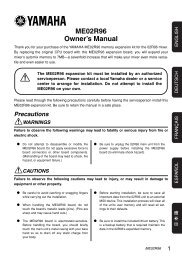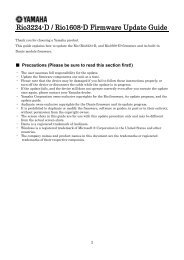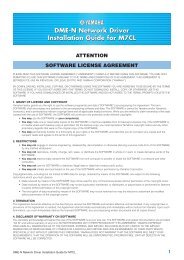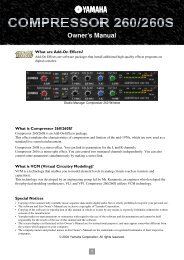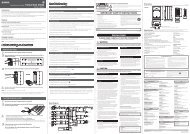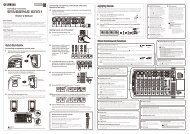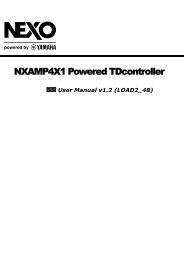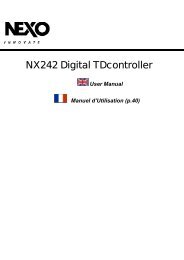You also want an ePaper? Increase the reach of your titles
YUMPU automatically turns print PDFs into web optimized ePapers that Google loves.
P.4 INTRODUCTIONINTRODUCTIONThank you for selecting NEXO <strong>GEO</strong> S <strong>Series</strong> products. This manual is intended to provide you withnecessary and useful information about your <strong>GEO</strong> System, which includes the following products:• S805 5° Tangent Array Module. 8” (20cm) Neodymium Hi-flux 16 Ohm LF Driver and 1”Throat Neodymium HF Driver on a 5° Hyperboloid Reflective Wavesource. Your mainbuilding block for curved vertical tangent arrays; integral precision array assembly system.• S830 30° Tangent Array Module. 8” (20cm) Neodymium Hi-flux 16 Ohm LF Driver and 1”Throat Neodymium HF Driver on a 30° Hyperboloid Reflective Wavesource. The buildingblock for horizontal tangent arrays, and the tangent down-fill element for curved verticalarrays; integral precision array assembly system.• CD12 HyperCardoid Subbass. Two 12” (30cm) Long Excursion Neodymium 6 Ohm Drivers,each controlled by one DSP channel, creating a 120° x 120° hypercardioid pattern. Can beflown or ground-stacked.• NX242 Digital TDcontroller. Provides comprehensive control of the above <strong>GEO</strong> S <strong>Series</strong>loudspeakers in multiple configurations. For a complete description of this unit, please referto the NX242 User Manual. Please remember that the NX242 Digital TDcontroller’s DSPalgorithms and parameters are software and are updated regularly. Please consult theNEXO web site (www.nexo.fr or www.nexo-sa.com) for the latest software releases.• <strong>GEO</strong> Flying System. Coupled with the integral array assembly system on <strong>GEO</strong> S <strong>Series</strong>cabinets, provides safe, flexible and simple means of flying <strong>GEO</strong> Tangent Arrays. NOTE:<strong>GEO</strong> Tangent Arrays control the dispersion of acoustic energy with a high degree ofprecision. Inclinometers and laser aiming devices are essential to ensure proper audiencecoverage when hanging or flying a <strong>GEO</strong> Tangent Array.• <strong>GEO</strong>Soft2 Array Design Software. MATLAB based Windows software simplifies the designand implementation of vertical tangent <strong>GEO</strong> arrays.Please devote some attention to reading this manual. A comprehensive understanding of <strong>GEO</strong>waveguide theory, tangent arrays, and specific features of the <strong>GEO</strong> S <strong>Series</strong> will help you to operateyour system at its full potential.
GENERAL SET-UP INSTRUCTIONS P.5GENERAL SET-UP INSTRUCTIONSSpeaker WiringThe loudspeakers are connected to power amplifiers viaNL4FC SPEAKON connectors (not supplied). A wiringdiagram is printed on the connection panel located on theback of each cabinet. The in/out pins of the SPEAKONsockets are identified. The sockets are connected inparallel within the enclosures (see the ConnectionsDiagrams section of this manual). Either connector canbe used to connect power amplifiers or to power anadditional <strong>GEO</strong> Tangent Array Module (NEXOrecommend a maximum of six S <strong>Series</strong> Tangent ArrayModules per amplifier channel).NB: The front loudspeaker of the CD12 is wired 2+ & 2-while the rear loudspeaker is wired 1- & 1+. NEVERconnect the CD12 to the <strong>GEO</strong> S805/S830.Cable choice consists mainly of selecting cables of thecorrect sectional dimension (size) in relation to the loadresistance and the cable length. Too small a cablesection will increase both its serial resistance and itscapacitance; this reduces the electrical power delivered tothe loudspeaker and can also induce response (damping factor) variations.For a serial resistance less or equal to 4% of the load impedance (damping factor = 25), the maximum cablelength is given by:L max = Z x S S in mm 2 , Z in Ohms, L max in metersThe table below indicates these values, for 3 common sizes.Load Impedance (Ω) 2 3 4 6 8 12 16Cable sectionMaximum Length (meters)1,5 mm² (AWG #14) 3 4.5 6 9 12 18 242,5 mm² (AWG #12) 5 7.5 10 15 20 30 404 mm² (AWG #10) 8 12 16 24 32 48 64Examples :The <strong>GEO</strong> S805 and S830 have a nominal impedance of 16 ohms, so a 6x <strong>GEO</strong> S8 cluster wired in parallelwill present a 16/6 = 2.7 Ohms load impedance. The maximum acceptable 2x2.5 mm 2 (AWG #12) cablelength L max for such a cluster is 6.75 meters.The CD12 subwoofer has a nominal impedance of 2 x 6 Ohms, therefore 2 CD12s wired in parallel willpresent a 2 x 3 Ohms load impedance. The maximum acceptable 4x4 mm 2 (AWG #10) cable length L max isthen 12 meters.IMPORTANT NOTE: Long speaker cables induce capacitive effects – up to hundreds of pF depending on thequality of the cable, with a high-pass effect in high frequencies. If long speaker cables must be used, ensurethat they do not remain coiled while in use.
P.6 GENERAL SET-UP INSTRUCTIONSAmplifier SelectionPower<strong>GEO</strong> S8 <strong>Series</strong> array elements are rated for 500 Watts power handling. Although each array element has a16 Ohm nominal impedance, NEXO recommends that you connect no more than six S8 <strong>Series</strong> arrayelements to a single amplifier channel. The amplifiers used for this application should be capable of delivering1500 to 3000 Watts into a low impedance (typically specified as 2 Ohm) load. Budget constraints are the onlyreason to select lower output power amplifiers. A lower power amplifier will not reduce the chances of driverdamage due to overexcursion, and may actually increase the risk of thermal damage due to sustainedclipping.The CD12 requires two amplifier channels delivering separately processed signals to produce itshypercardioid pattern. The amplifier model should be the same as that used for the <strong>GEO</strong> S8 <strong>Series</strong> arrayelements. Two CD12s can be connected in parallel: take care that both front woofers and both rear woofersare connected in parallel.Current ratingIt is very important that the amplifier behaves correctly under low load conditions. A speaker system is reactiveby nature: on transient signals like music it will require four to ten times more instantaneous current than itsnominal impedance would indicate. Amplifiers are generally specified by continuous RMS power into resistiveloads, however the only useful information about current capacity is the specification into a 2 Ohm load. It ispossible to perform an amplifier listening test by loading the amps with twice the number of cabinetsconsidered for the application (2 speakers per channel instead of one, 4 instead of 2) and running the ampsup to the onset of clipping. If the signal does not noticeably deteriorate, the amplifier is well adapted(overheating after approximately ten minutes is normal but thermal protection must not operate too quicklyafter starting this test).Amplifier gain settingsTechnical knowledge of the amplifiers to be used with the system is essential. This data is the key to thecorrect alignment of the system. It is especially important to know the gain of all amplifiers used in your set-up.The tolerance should be about ±0.5 dB. In practice this can be difficult to achieve because:• Some amplifier brands have an identical input sensitivity for models of different power rating(this infers a different voltage gain for each model). For example, a range of amplifiers withdifferent power outputs, all having a published input sensitivity of 775mV/0dBm or1.55V/+6dBm, will have a wide range of actual gains – the higher the power, the greater thegain.• Various other brands may offer constant gain but only within a given product range, forexample they may fit fixed input sensitivity only on their semi-professional amps.• Even if a manufacturer applies the constant gain rule to all models, the value selected willnot necessarily be the same as that chosen by other manufacturers.• Some products can exhibit manufacturing tolerances for the same model of ±1dB or more.Some amplifiers may have been modified, possibly without any label indicating the newvalues. Others may have gain switches fitted internally where it is impossible for the user toverify the actual setting without opening the amplifier casing. In cases where you don't knowthe gain of your amplifier (or want to check it) please follow this procedure:1) Unplug any loudspeakers from the amplifier outputs2) With a signal generator, feed a sine wave at 1000Hz at a known voltage (say 0.5V) tothe input of the amplifier under test3) Measure the voltage at the output of the amplifier4) Calculate the gain using the formula Gain = 20 * LOG10(Vout/Vin).
GENERAL SET-UP INSTRUCTIONS P.7Some examples:GainVin20dB 26dB 32dB 37dB (1.4V sensitivity / 1350Wrms)0.1V 1V 2V 4V 7.1V0.5V 5V 10V 20V 35.4V1V 10V 20V 40V 70.8VRemember that constant sensitivity settings will give a different gain value when the amplifier power isdifferent.Gain valueNEXO recommends low gain amplifiers: +26dB is recommended, as it is at the same time adequately low andquite common amongst amplifier manufacturers. This gain setting improves signal to noise ratio and allows allpreceding electronic equipment, including the NX242 TDcontroller, to operate at optimum level. Rememberthat using a high gain amplifier will raise the noise floor proportionally.Advanced protectionSome high-end amplifiers may include signal processing functions similar to those found in the NX242TDcontroller ("loudspeaker offset integration", "limiter", "compressor," etc.). These functions are not adapted tospecific system requirements and may interfere with the complex protection algorithms used in the NX242.NEXO do not advise using other protection systems in conjunction with the NX242 and they should bedisabled.Connection DiagramsThe NX242 TDcontroller provides two basic modes of operation with <strong>GEO</strong> S <strong>Series</strong> products, as shownbelow.1) Stereo <strong>GEO</strong> S8 with no CD12 sub,2) Mono <strong>GEO</strong> S8 with CD12 Sub.
P.8 NX242 DIGITAL TDCONTROLLER SETTINGSNX242 DIGITAL TDCONTROLLER SETTINGSThe <strong>GEO</strong> S <strong>Series</strong> cabinets will not perform correctly without the NX242 TDcontroller. Sound quality andreliability are totally dependent on the correct use of the NX242 TDcontroller, in accordance with theinstructions provided in this manual and in the NX242 User Manual.All manuals & associated technical notes must be read before set-up. Please contact your NEXO agent forany literature you may need. The NX242 Digital TDcontroller is able to drive the entire current NEXO range(<strong>GEO</strong>, PS & Alpha series, CD12 subs). The following <strong>GEO</strong> set-ups are examples, for a complete and updatedlist please refer to the documentation describing the NX-LOAD.<strong>GEO</strong> Vertical ArraysInput/Output Assignments:<strong>GEO</strong> S8 <strong>Series</strong> Wideband Configurations (No Sub)Input ALeftInput BRightOutput 4 HF Output 3 HF Output 2 LF Output 1 SubLeft Right No Signal No SignalS805 4-8 boxes No SubStereo Setup. Input A (Left) & B (right). Output 3 (left) and 4 (right). No signal on output 1 &2.Configure <strong>GEO</strong> S805 Wideband for 4-8 boxes.S805 9-16 boxes No SubStereo Setup. Input A (Left) & B (right). Output 3 (left) and 4 (right). No signal on output 1 &2.Configure <strong>GEO</strong> S805 Wideband for 9-12 boxes.Input/Output Assignments: <strong>GEO</strong> S8 + CD12 ConfigurationsInput A Input BMonoNo SignalOutput 4 HF Output 3 HF Output 2 LF Output 1 SubNo Signal <strong>GEO</strong> S8 CD12 Front Driver CD12 Back DriverS805 4-8 boxes CD12 GroundMono Setup. Input A. Output 1 (back driver of the CD12), Output 2 (front driver of the CD12), Output 3 (<strong>GEO</strong>),no signal on Output 4.Configure <strong>GEO</strong> S805 (4-8 boxes) with CD12.S805 9-6 boxes CD12 GroundMono Setup. Input A. Output 1 (back driver of the CD12), Output 2 (front driver of the CD12), Output 3 (<strong>GEO</strong>),no signal on Output 4.Configure <strong>GEO</strong> S805 (9-16 boxes) with CD12.S805 4-8 boxes CD12 FlownMono Setup. Input A. Output 1 (back driver of the CD12), Output 2 (front driver of the CD12), Output 3 (<strong>GEO</strong>),no signal on Output 4.Configure <strong>GEO</strong> S805 (4-8 boxes) with CD12 flown.
NX242 DIGITAL TDCONTROLLER SETTINGS P.9S805 9-16 boxes CD12 FlownMono Setup. Input A. Output 1 (back driver of the CD12), Output 2 (front driver of the CD12), Output 3 (<strong>GEO</strong>),no signal on Output 4.Configure <strong>GEO</strong> S805 (9-16 boxes) with CD12 flown.<strong>GEO</strong> Horizontal Tangent ArraysInput/Output Assignments: <strong>GEO</strong> S8 <strong>Series</strong> WidebandConfigurations (No Sub)Input A Input BLeftRightOutput 4 HF Output 3 HF Output 2 LF Output 1 SubLeft Right No Signal No SignalS830 3 boxes No SubStereo Setup. Input A (Left) & B (right). Output 3 (left) and 4 (right). No signal on output 1 &2.Configure three <strong>GEO</strong> S830 Wideband.Input/Output Assignments: <strong>GEO</strong> S8 + CD12 ConfigurationsInput A Input BMonoNo SignalOutput 4 HF Output 3 HF Output 2 LF Output 1 SubNo Signal <strong>GEO</strong> S8 CD12 Front Driver CD12 Back DriverS830 3 boxes CD12 FlownMono Setup. Input A. Output 1 (back driver of the CD12), Output 2 (front driver of the CD12), Output 3 (<strong>GEO</strong>),no signal on Output 4.Configure three <strong>GEO</strong> S830 with a CD12 flown.S830 3 boxes CD12 GroundMono Setup. Input A. Output 1 (back driver of the CD12), Output 2 (front driver of the CD12), Output 3 (<strong>GEO</strong>),no signal on Output 4.Configure three <strong>GEO</strong> S830 with a CD12 ground.Speaker QuantitySpeaker Quantity (MENU 1.7)parameter acts on an ArrayEQ that has been tuned toreduce the coupling effect ofmultiple <strong>GEO</strong> cabinets at LowFrequencies. It will help youto fine tune your systemaccording to the number ofcabinets and personal taste.Array EQ is at 0dB whenSpekaer Quantity is 8, boostsfor lower quantities, and cutsfor higher quantities.
P.10 NX242 DIGITAL TDCONTROLLER SETTINGSDelays & System AlignmentThe NX242 internal time adjustments (factory presets) have been optimised to provide the best crossoverpossible between the MAIN and SUB systems. The reference point for this adjustment is the front side ofeach cabinet. (That means that the internal delays are set for a S8 cabinet standing close to the CD12, withboth front sides being aligned).Should you rig your CD12 behind the S8, you will have to delay the MAIN system the according distance D.The delay parameter is set in MENU 1.2 (set the units to meters or feet according to your preference).Should you leave your CD12 on the ground, you will have to adjust the delay on the CD12 (using MENU 1.2)according to the path difference between the flown <strong>GEO</strong> and the ground stacked CD12. We recommend youto adjust your system for the more distant listening point.In the following case where A is the average height, B the listening point and C the difference between frontsides of both systemsCD12 Delay = A 2 + B2 − B ± C (specify meters or feet)If this formula gives a negative result the delay should be implemented on the MAIN channel.DAB+C -CInitial Set-up PrecautionsWhen running up a system that includes new cabinets for the first time, the power should be increased slowlyto approximately 50% and the system operated at this level for two hours. During the following two hours ofoperation the power level should be limited to approximately 75%. This procedure allows the adhesives andsuspensions within the loudspeaker components to stabilise and will extend their working life.In all cases, it is advisable to connect the loudspeakers only after all the other components have been wiredand are operating correctly. This is particularly important for the amplifiers and the TDcontroller. It is a goodpractice to turn down all the amplifier gains before connecting the cabinets and then turn them up againindividually with a medium level music source fed into the system. The sense LEDs of the correspondingTDcontroller channel should light up accordingly. This will help to locate cabling errors, particularly channelline inversions, which would disable the TDcontroller protections and may invalidate the warranty.IMPORTANTIf more than one amplifier is being driven from an output of the NX242 TDcontroller, only those amplifiers thatare not connected to sense inputs may be attenuated. If the sensed amplifier is attenuated and the slaveamplifiers are not, severe system damage will result!
DEPLOYING <strong>GEO</strong> TANGENT ARRAYS P.11DEPLOYING <strong>GEO</strong> TANGENT ARRAYSVertical vs. HorizontalOne of the advantages of the <strong>GEO</strong> S <strong>Series</strong> is the ability to construct coherent vertical and horizontal arraysfrom the appropriate <strong>GEO</strong> Tangent Array Modules. These two types of arrays are very different in theirbehaviour and intended applications.Vertical tangent arrays of <strong>GEO</strong> are intended for applications where the horizontal coverage (80 or 120º) issuitable for the application and even SPL from the first row to the last row of the audience is desired. The<strong>GEO</strong>Soft2 software will help you design a vertical array of S805 and S830 cabinets and tailor the acousticwave generated by the cluster to fit your audience profile, providing equal power to equal areas. When doneproperly, the <strong>GEO</strong> S <strong>Series</strong> can provide extremely even SPL throughout the depth of your audience, includingbalcony coverage.Horizontal tangent arrays of <strong>GEO</strong> S830 cabinets provide exceptional control of horizontal coverage but arenot intended to provide the same even SPL capability as a vertical array. Horizontal arrays deliver equalpower to equal angles, with SPL decreasing as you move further back in the audience. However, the <strong>GEO</strong>S830 is designed to array tangentially with adjacent S830 cabinets providing a much more coherent wavefront from an array of multiple cabinets than conventional arrayable cabinets. This allows the user to provide30º increments of horizontal coverage as needed.CD12 HyperCardioid SubbassThe CD12 is a hypercardioid subbass device providing directional low frequency energy with a dramaticreduction in low frequencies behind the loudspeaker(s). This is achieved using the interaction of twoindependently driven 12” drivers, highly specialized ports, and the digital processing capabilities of the NX242Loudspeaker Controller.It is important to follow these guidelines to attain the best performance from the CD12;• Keep at least 3’ to 4’ (1m) of space around the CD12(s) when they are located on theground. Objects or barriers within this space can interfere with the interaction of wave frontsfrom the front and rear of the CD12.• Drive the front and rear drivers with identical amplifier channels set to the same gain. Theoperation of the CD12 is based on the assumption that both the front and rear sub-systemsare identical in terms of the amplifier’s electrical performance.• When flying the CD12(s), use the linking bar to connect the CD12 bumper to the <strong>GEO</strong>Bumper and keep at least 50cm (~20”) of space between the back of the <strong>GEO</strong> cabinets andthe front of the CD12(s).. It provides enough distance that the <strong>GEO</strong> cabinets will notinterfere with the acoustical wave front from the CD12. For time alignment with the mainsystem see page 10 “Delays & System Alignment”• When ground stacking the CD12, it is better to stack them vertically than horizontally.• When hanging or stacking multiple CD12 cabinets make sure they are all oriented correctly;fronts forward and tops up. Do not hang one CD12 upside down relative to the others.
P.12 <strong>GEO</strong>SOFT2<strong>GEO</strong>SOFT2<strong>GEO</strong>Soft2 software processes measured speaker data with complex mathematical algorithms to assist theuser in designing vertical tangent <strong>GEO</strong> arrays that provide even SPL throughout the depth of the audience.Due to the complexity of the interaction of multiple cabinets, it is simply not possible to reliably design curvedvertical arrays without using the processing power of a computer to predict the optimum array structure for agiven audience geometry. The design logic is far more complex than looking at a section drawing of thevenue, measuring the overall angle needed to cover the audience from your cluster location, and dividing by5º to determine the number of S805 cabinets you will need.<strong>GEO</strong>Soft2 is an easy to use tool that will allow you to shape the energy leaving the cluster to fit your audience.In addition you will be able to predict the average and peak SPL of the system to ensure you have providedenough cabinets for the application.<strong>GEO</strong>Soft2 is used only for determining the structure of the cluster to attain proper coverage in the verticalplane. In the horizontal plane, you project 80º, 100º, or 120º degrees of horizontal coverage from your clusterlocations on a plan view of the venue to determine optimum locations for your hanging points.For a more complete and up-to-date information, Geosoft2 can be downloaded from Nexo’s websitewww.nexo-sa.com. Please check that link for application examples and latest upgrades periodically.
USING THE CONFIGURABLE DIRECTIVITY DEVICE P.13USING THE CONFIGURABLE DIRECTIVITY DEVICEThe <strong>GEO</strong> Wavesource controls dispersion of acoustic energy using an hyperboloid acoustical reflector in the“coupling plane” (the vertical plane of a curved vertical tangent array) and a diffraction slot in the “non-couplingplane” (the horizontal plane of a curved vertical tangent array). The patent-pending Configurable DirectivityDevice consists of bolt-on flanges that alter the diffraction slot’s exit flare rate. The flanges look like this:In the graph below, the red curve shows the dispersion in the non-coupling plane with the flanges installed:the narrower blue curve shows the dispersion without the flanges.180°COVERAGE ANGLE (Degree)120°60°Angle [°]0°−60°−120°−180°1kFreq [Hz]10k<strong>GEO</strong> Hyperboloid Reflective Wavesourcewith Configurable Directivity Device flangesNon-coupling plane dispersion vs. frequency, with(120° black) and without (80° grey) ConfigurableDirectivity flanges installedInstalling & removing <strong>GEO</strong>’s Configurable Directivity flanges<strong>GEO</strong> S805 are shipped in the 80° dispersion (without the flanges installed). <strong>GEO</strong> S830 <strong>Series</strong> loudspeakersare shipped with the flanges installed (120° dispersion in the non-coupling plane). To remove the flanges fornarrower 80° dispersion in the non-coupling plane, remove the front grill and the four TORX (head 25) screwsin each side of the <strong>GEO</strong> Wavesource. Store these screws with the flanges. To fill in the holes, use the shorterreplacement screws provided with your <strong>GEO</strong> S8 <strong>Series</strong> loudspeaker. Do not attempt to screw the longerflange attachment screws into the waveguide attachment points: this will damage your <strong>GEO</strong> S8 <strong>Series</strong>loudspeaker’s Hyperboloid Reflective Wavesource.NOTE: A torque of 1N.m maximum shall be applied to the screw. NEVER USE POWER TOOLS TOINSTALL OR REMOVE CDD FLANGES: THEIR EXCESSIVE TORQUE CAPABILITY CAN EASILYDAMAGE THE <strong>GEO</strong> WAVESOURCE.M5x12M5x25
P.14 USING THE CONFIGURABLE DIRECTIVITY DEVICEWhen & where to use Configurable Directivity flangesThe diagram below can be considered as a plan view of the audience area shown in Figure 1. Instead oflooking through the sidewall, we are looking through the ceiling. While the <strong>GEO</strong> cluster will deliver even SPLfrom the front to the rear of this audience area, there are “holes” near the front in the centre and at the outsideedges. We cannot fill the outside coverage gaps without enlarging the centre gap, and vice versa.- Figure 1 :Plan view of coverage using two <strong>GEO</strong> curved vertical arrayswithout Configurable Directivity flanges- Figure 2 : Plan view of coverage using two <strong>GEO</strong> curved verticalarrays. Both Configurable Directivity flanges have been installed inthe bottom two cabinets of the clusters.However, if we install Configurable Directivity Devices in the bottom two cabinets of the cluster, coverage willlook more like the pattern in Figure 2.In curved vertical arrays, the Configurable Directivity Device can be used:• On the bottom two rows of curved vertical arrays, to fill in coverage gaps in the front rows.• On all rows of curved vertical arrays, in cases where 240° of horizontal coverage is preferred to160°.In horizontal arrays of <strong>GEO</strong> S830s, the Configurable Directivity Device can be removed to narrow the verticalcoverage of the array from 120° to 80°.- Sectional view of a 100’ deep space, showing coverage alternatives using <strong>GEO</strong> S830 arrays aimed straight down, with (right) andwithout (left) CDD flanges.
<strong>GEO</strong> APPLICATION GUIDELINES P.15<strong>GEO</strong> APPLICATION GUIDELINES<strong>GEO</strong> is a highly adaptable and flexible system due to the unique performance factors of the patent-pendingHyperboloid Reflective Wavesource, the Configurable Directivity Device flanges and other innovations.However, like all tools, your <strong>GEO</strong> system has been designed to function in specific ways: these lendthemselves to many situations, but not all. When designing and deploying <strong>GEO</strong> arrays, keep the followingconsiderations in mind.Minimum Array Height (Vertical Tangent Arrays)Like any “line array,” <strong>GEO</strong>’s ability to control lower frequencies with longer wavelengths is determined by theheight of the array. NEXO recommend that curved vertical <strong>GEO</strong> tangent arrays include at least four (4) S805’sand one (1) S830. Lines shorter than this will not provide adequate control of lower frequencies. You will seethis in <strong>GEO</strong>Soft2: the black dBA trace will curve downward and will approach the red HF trace towards therear of the listening area. This indicates that lower frequencies are falling in level relative to the higherfrequencies.Optimum Height of the BumperCan be found by experimenting with different heights and aiming angles in <strong>GEO</strong>Soft2. Your system can alsobe ground staked by using the proper accessory and the later revision of the <strong>GEO</strong>Soft2 which allow thesimulation of ground-stacked <strong>GEO</strong> vertical arrays.How Loud for the Crowd?Keep in mind that due to the superior coherency of <strong>GEO</strong> arrays, you may not need to get as loud in order to“hear what is going on” as was the case with previous generations of sound reinforcement loudspeakers usingcoercive megaphone-variant horn designs. The following chart offers some guidelines about the capability ofcurved vertical <strong>GEO</strong> tangent arrays of various lengths. Maximum values in dBA are for all cabinets angled at0.31°, minimum values are for all cabinets angled at 5° ; these values are calculated for open air conditions.For an audience of the indicated total length, the ±3 dB value will probably fall somewhere in between the Minand Max values. So a four-tall vertical tangent array, you will be able to produce levels of between 105 dBAand 110 dBA from the front to the rear of a 10m long audience area, and from 87 to 92 dBA throughout an80m long audience area.<strong>GEO</strong> ArrayTotal Length of Audience AreaArray Length Output ±3 dB 10 meters 20 meters 40 meters 80 meters4 x S805 dBA Min 105 99 93 87dBA Max 110 104 98 928 x S805 dBA Min 106 100 94 88dBA Max 111 108 104 9812 x S805 dBA Min 107 101 95 89dBA Max 111 108 105 10016 x S805 dBA Min 107 102 96 90dBA Max 113 110 107 104
P.16 <strong>GEO</strong> TANGENT ARRAY RIGGING SYSTEM<strong>GEO</strong> TANGENT ARRAY RIGGING SYSTEMBefore proceeding with assembly of <strong>GEO</strong>S / CD12 arrays, please ensure that the components are presentand undamaged. A component list is appended to this manual. In the event of any shortage, please contactyour supplier.SAFETY FIRSTGeoS / CD12 Rigging System has been approved by Certification Organization RWTÜV. Structuralcomputations, test reports, certificates are available in Geosoft2 or at Nexo (info@nexo.fr) upon request.We include this section to remind you of safe practice when flying the <strong>GEO</strong>S / CD12 system. Please read itcarefully. However, user must always apply his or her knowledge, experience and common sense. If in anydoubt, seek advice from your supplier or NEXO agent.This manual offers guidance only for GeoS / CD12 loudspeaker systems. References in this manual to otherrigging equipment such as motor hoists, steels, shackles etc. are made to clarify the description of GeoS /CD12 procedures. The user must ensure that operators are properly trained by other agencies in the use ofthese items.The <strong>GEO</strong>S / CD12 Rigging System has been optimised for the deployment of curved vertical tangent arraysof <strong>GEO</strong> S805 / S830 / CD12 loudspeakers. Vertical angle adjustment between cabinets has been limited tospecific settings to ensure correct acoustic coupling.The <strong>GEO</strong>S / CD12 Rigging System is a professional precision tool set, and should be handled with extremecare. Only persons who are fully conversant with the operation of the <strong>GEO</strong>S / CD12 Rigging System andprovided with suitable safety equipment should deploy <strong>GEO</strong> Arrays. Misuse of the <strong>GEO</strong>S / CD12 RiggingSystem could lead to dangerous consequences. Please refer to the safety section of this manual for adviceconcerning <strong>GEO</strong>S / CD12 Rigging System installation and handling.Used and maintained correctly, the <strong>GEO</strong>S / CD12 Rigging System will give many years of reliable service inportable systems. Please take the time to read and understand this manual. Always use <strong>GEO</strong>Soft2 todetermine the optimum angle settings for a particular venue, hang point and curved vertical <strong>GEO</strong>S / CD12array. Applied forces and moments are strongly cabinet quantity and angle configuration dependent. Clusterconfiguration must be implemented and validated in Geosoft2 prior to installation.Flown Systems Safety• Always inspect <strong>GEO</strong>S / CD12 Rigging System components for damage before assembly.Pay special attention to lifting points and safety clips. If you suspect that any of thecomponents are defective DO NOT USE THE AFFECTED PARTS. Contact your supplierfor replacements.• Read this manual carefully. Also be familiar with the manuals and safe working proceduresfor any ancillary equipment that will be used with the <strong>GEO</strong>S / CD12 Rigging System.• Ensure that all local and National regulations regarding the safety and operation of flyingequipment are understood and adhered to. Information on these regulations may usually beobtained from Local Government Offices.• When deploying the <strong>GEO</strong>S / CD12 Rigging System always wear protective headgear,footwear as well as eye protection.• Do not allow inexperienced persons to handle the <strong>GEO</strong>S / CD12 Rigging System.Installation personnel should be trained in loudspeaker flying techniques and should be fullyconversant with this manual.• Ensure that motor hoists, hoist control systems and ancillary rigging components arecurrently certified as safe and that they pass a visual inspection prior to use.• Ensure that public and personnel are not allowed to pass beneath the system during theinstallation process. The work area should be isolated from public access.
<strong>GEO</strong> TANGENT ARRAY RIGGING SYSTEM P.17• Never leave the system unattended during the installation process.• Do not place any object, no matter how small or light, on top of the system during theinstallation procedure. The object may fall when the system is flown and is likely to causeinjury.• Motor or hoist secondary safety steels must be installed once the system has been flown tothe operating height. Secondary steels requirements depend on the local safety standardsapplicable to the territory.• Ensure that the system is secure and prevented from pivoting around the motor hoist.• Avoid any form of excessive dynamic loading to the assembly (structural computations onGeoS Rigging System are based on a 1/1.2 factor for hoist or motor acceleration).• NEVER attach any item to the <strong>GEO</strong>S / CD12 system other than NEXO <strong>GEO</strong>S / CD12accessories.• When flying outdoor systems ensure that the system is not exposed to excessive wind orsnow loads and is protected from rainfall.• The <strong>GEO</strong>S / CD12 Rigging System requires minimum yearly inspection by a competentperson. Please follow local regulations for inspection procedures.• When de-rigging the system ensure that the same care is given to the load out procedureas for installation. Pack <strong>GEO</strong>S / CD12 Rigging System components carefully to preventdamage in transit.Ground Stacking SafetyStatistically, many more injuries occur due to unstable ground stacked PA systems than those associated withflown systems. There are several reasons for this fact, however the message is clear:• Always survey the supporting structure upon which a ground stack is to be built. Alwayslook beneath PA wings to inspect the deck support and if necessary ask for the stagescrims and dressings be removed to allow access.• If the stage surface slopes, as it does in some theatres, ensure that the system is preventedfrom sliding forwards due to vibration. This may require the fitting of timber battens to thestage floor.• For outdoor systems ensure that that the system is protected from wind forces which mightcause the ground stack to become unstable. Wind forces can be huge, especially uponlarge systems, and should never be underestimated. Observe meteorological forecasts,calculate the “worst case” effect upon the system prior to erection and ensure that thesystem is secured appropriately.• Take care when stacking cabinets. Always employ safe lifting procedures and never attemptto build stacks without sufficient personnel and equipment.• Never allow anyone, whether operators, artists or members of the public to climb onto aground stacked PA system. Anyone who needs to climb over 2m high should be fitted withsuitable safely equipment including a clip-on harness. Please refer to local Health andSafety legislation in your territory. Your dealer can help with advice on access to thisinformation.• Apply the same attention to all safety matters when de-stacking systems.• Be aware that safety procedures are as important in the truck and in the warehouse as theyare at the venue.
P.18 <strong>GEO</strong> TANGENT ARRAY RIGGING SYSTEMContactsCorrect training is fundamental to safe practise when working with loudspeakers flying systems. NEXOrecommend that users contact local industry associations for information on specialist course.Information for International training agencies can be obtained by contacting either:The Production Services Association (PSA),School Passage,Kingston-upon-Thames,KT1 SDU Surrey,ENGLANDTelephone: +44 (0) 181 392 0180Rigstar Training and Testing Center82 Industrial Dr. Unit 4Northampton, Massachusetts 01060 U.S.A.Phone: 413-585-9869 -- Fax: 413-585-9872school@rigstar.comESTAEntertainment Services & Technology Association875 Sixth Avenue, Suite 1005NEW YORK, NY 10001 USAPhone: 212-244-1505 – Fax: 212-244-1502info@esta.org - www.esta.org<strong>GEO</strong> LoudspeakersFront connectionpointAngle setting platePivot pointAngle setting barAvoids the barof the last cabinet to fall<strong>GEO</strong> S850 and S830 Tangent Array Modules are shipped from the factory with identical array assemblyhardware. The <strong>GEO</strong> Tangent Array Assembly System has three attachment points on each side. The pointsin the front connect each <strong>GEO</strong> cabinet to the adjacent enclosures above and below. The angle betweencabinets is set by attaching one end of the angle-setting bar to the proper hole on the angle-setting plate,which extends beyond the rear of the cabinet.The front connection points and the angle-setting holes in the angle plate are milled for the supplied pins,which have a diameter of 8 mm. Possible replacements for specific applications include:• Nuts and bolts with a diameter of 8mm or 5/16 in. (7.94 mm) for fixed installation• 8mm (NEXO REF: BL<strong>GEO</strong>S) or 5/16 in pins with spring-loaded locking balls for quickerarray assembly and disassembly in portable applications.
<strong>GEO</strong> TANGENT ARRAY RIGGING SYSTEM P.19Angle-setting barAngles between cabinets are set using the force ofgravityThe angle setting pivots on the hole marked 1. For all angles up toand including 17.5°, use the oblong hole on the unattached end ofthe bar (A). This allows you to set the angles of the array while thecabinets are lying flat on the ground. When the array is lifted intoposition each cabinet will fall automatically into the proper angle.The 30° angle adjustment is always fixed, use hole marked 2, and is set using the hole on the very end of theangle-setting bar (B). This allows you to set the proper angles for <strong>GEO</strong> S830 cabinets regardless of whetherthe array is deployed vertically or horizontally.Fixed Angle-Setting PointsFor applications where setting the angles via gravity is either impossible (i.e. ground stacking) or undesirable(fixed installations), remove the front pin from the angle-setting bar and re-attach it at point 2. This pivot pointis the same distance from the hole at the other end of the angle-setting bar as point 1 is from the end of theoblong slot. This makes it possible to set all angles up to 17.5° directly by attaching the angle-setting bar to theappropriate hole in the plate. For fixed angles, insert the pin through the hole at the tip of the angle-setting bar.Assembling a curved vertical <strong>GEO</strong> arrayAttach the top cabinet to the bumperThe <strong>GEO</strong> Bumper is symmetrical, enabling you to use <strong>GEO</strong> loudspeakers in a left/right stereo configuration.The connection between the top <strong>GEO</strong> enclosure and the bumper determines the left/right orientation for theentire array. Figure 3 shows the woofer on the left, and Figure 4 shows the woofer on the right. If you attachthe top <strong>GEO</strong> enclosure in this way, you must remove and replace the angle-setting plates in order to properlyattach the top <strong>GEO</strong> enclosure at the rear of the bumper.- Figure 3- Figure 4
P.20 <strong>GEO</strong> TANGENT ARRAY RIGGING SYSTEMAfter having positioned the top enclosure, insert the pinsinto the front and rear attachment points and lock themwith R clips (see picture). The bumper’s rear mountingpoint should be connect to the hole marked “LIFT” on the<strong>GEO</strong> Angle Adjustment Plate. NOTE: The top <strong>GEO</strong>enclosure is always parallel to the bumper.Assembling a vertical <strong>GEO</strong> tangent arrayPlace the top <strong>GEO</strong> cabinet (attached to the bumper) facedown on a horizontal surface (a narrow length of carpetwill help protect the grills). Align the top holes of the next<strong>GEO</strong> cabinet’s front attachment bar with the bottomholes of the first <strong>GEO</strong> cabinet’s front attachment bar andinsert the pins to connect both sides at the front (seebelow). Repeat this operation until the entire array isconnected at the fronts of the enclosures.LiftSetting the angles between adjacent<strong>GEO</strong> enclosuresTo set the angles between enclosures to thevalues specified for this array by <strong>GEO</strong>Soft2, beginby lifting the array until only the bottom enclosureremains on the ground. This will make it easier toalign the angle-setting bars with the proper holesin the angle-setting plates (see Figure 5).Align the angle-setting bars with the proper holesin the angle-setting plates. For all <strong>GEO</strong>enclosures except the S830, insert pins throughthe hole in the angle-setting plate and the oblongslot at the end of the angle-setting bar (see Figure6).NOTE: <strong>GEO</strong> S830’s are always “tight-packed” with the adjacent enclosure so that the wavefronts will betangent and will combine coherently without interference. The angle of a <strong>GEO</strong> S830 at the bottom of a curvedvertical array and just below a <strong>GEO</strong> S850 will therefore be 17.5°. The angle between any two <strong>GEO</strong> S830’s willalways be 30°.Continue lifting the array so that the fronts of all the enclosures are accessible, then lock all the attachmentpins in place with R-clips. While the array is being raised to the operating height specified by <strong>GEO</strong>Soft2, theenclosures will fall into the proper angular alignment with each other.- Figure 5- Figure 6CAUTION: The <strong>GEO</strong> Bumper is designed to safely fly a maximum of 24 <strong>GEO</strong> loudspeakers. Beforeraising the array to its operating height, be sure to check that all attachment pins are in place, securedby R-clips or another locking mechanism and that both sides angles settings are strictly identical.
<strong>GEO</strong> TANGENT ARRAY RIGGING SYSTEM P.21Extension Bar- Figure 7- Figure 8The <strong>GEO</strong> Bumper has two lift points, which are adequate for many situations. The extension bar is designedfor those applications where the bumper’s lift points are too close together to allow setting the proper tilt anglefor the entire array. With 16 <strong>GEO</strong> cabinets, a vertical <strong>GEO</strong> array can be tilted ±15°. NOTE: Always use aninclinometer and/or a laser aiming device to verify that the array has the tilt angle specified in <strong>GEO</strong>Soft2.The extension bar has several tilt-angle adjustment points. It must always be secured by inserting two of thesupplied 12mm pins into two of these points: pins must be locked in place with the supplied R-clips. The <strong>GEO</strong>bumper, with or without the extension bar, should be lifted by a single motor hoist using the two adjustablechains connected to a central flying ring (see Figure 8).CD12 BUMPERThe bumper of the CD12 is an independent hardware element that enables <strong>GEO</strong> users to fly one or moreCD12’s either alone or directly behind a <strong>GEO</strong> array. The CD12 bumper is shipped with four link steels. Toconnect the top CD12, attach these steels to the four rails located on the bumper and the four rails located onthe CD12 (Figure 9).- Figure 9
P.22 <strong>GEO</strong> TANGENT ARRAY RIGGING SYSTEMCombination <strong>GEO</strong>/CD12 bumperIt is possible to make a single bumper by using the connecting bar to join the <strong>GEO</strong> bumper and the CD12bumper. The cluster will then consist of:• The <strong>GEO</strong> enclosures, attached to the <strong>GEO</strong> bumper• The CD12 enclosures, attached to the CD12 bumper directly behind the <strong>GEO</strong> array• The connecting bar which joins the entire array assembly together.The procedures for attaching <strong>GEO</strong> loudspeakers and CD12 enclosures to their respective bumpers are thesame as previously explained.The connecting bar must be passed through the bodies of both bumpers and locked in position using two12mm pins for each bumper. These 12mm pins use the same R-clips as on the <strong>GEO</strong> pins (see Figure 10).NOTE: The list points of the CD12 Bumper are positioned on the centre of gravity of the CD12. They areoffset from the centre of the tube to allow the correct positioning when assembling a combination <strong>GEO</strong>/CD12bumper.If you are assembling left/right stereo arrays as described in section IV-1, you must reverse the CD12 bumperin order to maintain the correct orientation with respect to the <strong>GEO</strong> Array. In a frontal view of the cluster, the<strong>GEO</strong> array must be centred with respect to the CD12. (see Figure 11).CAUTION: In this configuration, the CD12 Bumper is designed to hang a maximum of 8 CD12enclosures.- Figure 10 - Figure 11
<strong>GEO</strong> TANGENT ARRAY RIGGING SYSTEM P.23Assembling Horizontal <strong>GEO</strong> ArraysHorizontal <strong>GEO</strong> arrays are composed exclusively of <strong>GEO</strong> S830 loudspeakers.In this configuration, it is imperative that the cabinets are “tight packed,” that is arrayed at 30° splay angles,matching the trapezoidal sides of the <strong>GEO</strong> S830 enclosures. This ensures that the wavefronts are trulytangent and combine without destructive interference.Up to three Horizontal <strong>GEO</strong> S830 arrays can be well hung by using the accessory <strong>GEO</strong>S-HRPL, attached tothe <strong>GEO</strong> Array Assembly System with 8mm rings and locking nuts. Always use the “LIFT” point for the rearattachment. To vary the vertical angle of the array, use different points for the front attachment. For mountinginstruction, please refer to the document shipped with the accessory.Ground stacking Geo ArrayUp to 8 <strong>GEO</strong> S805 cabinets can bestacked with the accessory <strong>GEO</strong>S-GRND. <strong>GEO</strong> S830 should never beground stacked together with <strong>GEO</strong>S805. The stacking configuration istaken into account in the <strong>GEO</strong>Soft2software. For mounting instruction,please refer to the document shippedwith the accessory.Before assembling for stackedconfiguration, remove the front pin fromthe angle-setting bar and re-attach it atpoint 2. This pivot point is the samedistance from the hole at the other endof the angle-setting bar as point 1 is fromthe end of the oblong slot. This makes itpossible to set all angles up to 5° directlyby attaching the angle-setting bar to theappropriate hole in the plate. For fixedangles, insert the pin through the hole atthe tip of the angle-setting bar.Properly adjust <strong>GEO</strong>S-GRND front andrear legs so that <strong>GEO</strong>S stack assemblyfootprint remains inside <strong>GEO</strong>S-GRNDfootprint.
P.24 <strong>GEO</strong> TANGENT ARRAY RIGGING SYSTEMDimensions & Weights<strong>GEO</strong>S-BUMPERWeight 11kg / 24.25 lbsCD12-BUMPERWeight 15kg / 33 lbsLink BAR (CD12-LINKBAR)Weight 9kg /19.8 lbs<strong>GEO</strong>/CD12 Extension BAR (EXBAR-S)Weight 4kg / 8.8 lbs
TECHNICAL SPECIFICATIONS P.25TECHNICAL SPECIFICATIONS<strong>GEO</strong> S805SYSTEM SPECIFICATIONSFrequency Response [a]Usable Range @-6dB [a]Sensitivity 1W @ 1m [b]Peak SPL @ 1m [b]Dispersion [c]Directivity Index [c]Crossover FrequencyNominal ImpedanceRecommended AmplifiersFEATURESComponentsHeight x Width x DepthShapeWeightConnectorsConstructionFront Finish<strong>GEO</strong> S805 with NX242 TDcontroller67 Hz – 19 kHz ± 3 dB60 Hz – 20 kHz99 dB SPL Nominal -97 dB SPL Wideband125 to 128 dB Peak for a single cabinet. Configuration dependant when arrayed.Coupling Plane: Not useable as a single cabinet. Configuration dependantNon-coupling plane: 120° (configurable to 80°).Not useable as a single cabinet. Configuration dependant1.8 kHz Passive16 ohms1500 to 3000 Watts into 4 ohms / 4 cabinets per channel. Up to 6 cabinets per channel may be connected tolarge amplifiers capable of operating into low impedance loads.<strong>GEO</strong> S805LF: 1 x 8” (20cm) Neodymium Hi-flux 16 Ohm DriverHF: 1 x 1” Throat Neodymium Driver on a Hyperboloid Reflective Wavesource406 x 250 x 219 mm (16” x 9 7/8” x 5 5/8”) without flying hardware5° Trapezoid13 kg (28.7 lbs) with Tangent Array Assembly System; 10.5 kg (23 lbs) net2 x NL4MP SPEAKON 4 pole (In & Through)Baltic Birch Ply finish with structured black coating.Perforated Steel GrillFlying points Integral flying system. Intercabinet Angle Adjustments = 0.31 to 5° (logarithmic steps), 17.5° & 30°SYSTEM OPERATIONElectronic ControllerThe NX242 Digital TDcontroller presets are precisely matched to the <strong>GEO</strong> S8-<strong>Series</strong> cabinets and includesophisticated protection systems. Using <strong>GEO</strong> S <strong>Series</strong> cabinets without a properly connected NX242 DigitalTDcontroller will result in poor sound quality and can damage components.HF Dispersion Configuration After quick release of the front grill from its fittings, the HF Waveguide can be configured for 80° or 120°dispersion in the non-coupling plane.Array DesignArrays of less than 4 <strong>GEO</strong> S805 will provide poor dispersion control and are not recommended or supported.S805 and S830 cabinets, having tangent waveguides, can be mixed in the same array.Sub-bassThe <strong>GEO</strong> S805 can be used without the optional CD12 Hypercardiod Sub. In this case the NX242 can be usedin stereo. With the CD12 Hypercardiod Sub each Sub channel requires two NX242 outputs and the NX242 willoperate in mono.Speaker CablesThe <strong>GEO</strong> S805 are wired 1- & 1+ on both Speakon connectors; 2- & 2+ are not connected.Rigging System428 mmSee corresponding chapter of this manual.[a] [b] [c] Seemeasurementnotes at the end ofCD12specifications302 mm276 mm5°Weight: 13 kg/28.7 lbs
P.26 TECHNICAL SPECIFICATIONS<strong>GEO</strong> S805 curves10ON AXIS RESPONSE (dB)64IMPEDANCE (Ohms)032−10−2016−3030 100 1k 10k 20kOn Axis response in dB. From dark to light: set up ‘wide range’, ‘CD12 stacked’ and ‘CD12flown’.830 100 1k 10k 20kImpedance in Ohms10OFF AXIS RESPONSE Flange 80° (dB)THD + N (%)10%01%−10−20100 1k 10k 20kOff axis response in dB in the non-coupling plane flange 80°.Dark to light: 0°, 10°, 20°, 30° and 40° off axis.0.1%100 1k 10k 20kTotal harmonic distortion + noise in percentage. Level = 110dB @ 1m.10OFF AXIS RESPONSE Flange 120° (dB)2500Hz305000 Hz03300030330603006030090 270−1090 270120240−20100 1k 10k 20kOff axis response in dB in the non-coupling plane flange 120°.From dark to light: 0°, 15°, 30°, 45° and 60° off axis.120150180210240150180210200˚100˚COVERAGE ANGLE (Degree)603010000 Hz0330300Flange 80° (dark) and flange120° (light) polar plot in thenon-coupling plane.3dB/division.90 27010˚100 1k 10k 20kTotal coverage @-6dB in the coupling plane in degrees.From dark to light: 1, 2 and 4 boxes.120150180210240200˚COVERAGE ANGLE (Degree)20Q & DI100100˚101020˚100 1k 10kTotal coverage @-6dB in the non-coupling plane in degrees:flange 80° (dark) and flange 120 (light).01100 1k 10k 20kDirectivity Index in dB (Left hand side scale) and directivity factor (Right hand side scale) for flange 120° (dark) and flange 80° (light).All measurements made with dedicated NX program.Measurements conditions: far field, half space below 400Hz; anechoic above 400Hz.Directivity Index and factor: computer synthesized from coverage. Coverage 1/3 rd octaveband synthesized from FFT measurements.
TECHNICAL SPECIFICATIONS P.27<strong>GEO</strong> S830SYSTEM SPECIFICATIONSFrequency Response [a]Usable Range @-6dB [a]Sensitivity 1W @ 1m [b]Peak SPL @ 1m [b]Dispersion [c]Directivity Index [c]Crossover FrequencyNominal ImpedanceRecommended AmplifiersFEATURESComponentsHeight x Width x DepthShapeWeightConnectorsConstructionFront Finish<strong>GEO</strong> S830 with NX242 TDcontroller67 Hz – 19 kHz ± 3 dB60 Hz – 20 kHz99 dB SPL Nominal -97 dB SPL Wideband125 to 128 dB Peak for a single cabinet. Configuration dependant when arrayedCoupling Plane: 30° for a single cabinet. Configuration dependantNon-coupling plane: 120° (configurable to 80°).DI = 12 Nominal (f > 1.5 kHz) for a single cabinet. Configuration dependant when arrayed.1.8 kHz Passive16 ohms1500 to 3000 Watts into 4 ohms / 4 cabinets per channel. Up to 6 cabinets per channel may be connected to largeamplifiers capable of operating into low impedance loads.<strong>GEO</strong> S830LF: 1 x 8” (20cm) Neodymium Hi-flux 16 Ohm DriverHF: 1 x 1” Throat Neodymium Driver on a Hyperboloid Reflective Wavesource406 x 250 x 219 mm (16” x 9 7/8” x 5 5/8”) without flying hardware30° Trapezoid13 kg (28.7 lbs) with Tangent Array Assembly System; 10.5 kg (23 lbs) net2 x NL4MP SPEAKON 4 pole (In & Through)Baltic Birch Ply finish with structured black coating.Perforated Steel GrillFlying points Integral flying system. Intercabinet Angle Adjustments = 0.31 to 5° (logarithmic steps), 17.5° & 30°SYSTEM OPERATIONElectronic ControllerHF Dispersion ConfigurationArray DesignSub-bassSpeaker CablesRigging SystemThe NX242 Digital TDcontroller presets are precisely matched to the <strong>GEO</strong> S8-<strong>Series</strong> cabinets and includesophisticated protection systems. Using <strong>GEO</strong> S <strong>Series</strong> cabinets without a properly connected NX242 DigitalTDcontroller will result in poor sound quality and can damage components.After quick release of the front grill from its fittings, the HF Waveguide can be configured for 80° or 120° dispersionin the non-coupling plane.S805 and S830 cabinets, having tangent waveguides, can be mixed in the same array.The S830 can be used without the optional CD12 Hypercardiod Sub. In this case the NX242 can be used instereo. With the CD12 Hypercardiod Sub each Sub channel requires two NX242 outputs and the NX242 willoperate in mono.The <strong>GEO</strong> S830 are wired 1- & 1+ on both Speakon connectors, 2- & 2+ are not connected.See corresponding chapter of this manual.[a] [b] [c] See measurement notes at the end of CD12 specifications428 mm276 mm302 mm30°Weight: 13 kg/28.7 lbs
P.28 TECHNICAL SPECIFICATIONS<strong>GEO</strong> S830 curves10ON AXIS RESPONSE (dB)64IMPEDANCE (Ohms)032−10−2016−3030 100 1k 10k 20kOn Axis response in dB. From dark to light: set up ‘wide range’, ‘CD12 stacked’ and‘CD12 flown’.830 100 1k 10k 20kImpedance in Ohms.10OFF AXIS RESPONSE Flange 80° (dB)THD + N (%)10%01%−10−20100 1k 10k 20kOff axis response in dB in the non-coupling plane flange 80°.Dark to light: 0°, 10°, 20°, 30° and 40° off axis.0.1%100 1k 10k 20kTotal harmonic distortion + noise in percentage. Level = 110dB @ 1m.10OFF AXIS RESPONSE Flange 120° (dB)2500Hz05000 Hz030330303300603006030090 27090 270−10120240120240−20100 1k 10k 20kOff axis response in dB in the non-coupling plane flange 120°.From dark to light: 0°, 15°, 30°, 45° and 60° off axis.150180210150180210200˚100˚COVERAGE ANGLE (Degree)603010000 Hz0Flange 80° (dark) and flange 120° (light) polar330300plot in the non-coupling plane. 3dB/division.90 27012024010˚100 1k 10k 20kTotal coverage @-6dB in the coupling plane in degrees.From dark to light: 1, 2 and 4 boxes.150180210200˚COVERAGE ANGLE (Degree)20Q & DI100100˚101020˚100 1k 10kTotal coverage @-6dB in the non-coupling plane in degrees: flange80° (dark) and flange 120 (light).01100 1k 10k 20kDirectivity Index in dB (Left hand side scale) and directivity factor(Right hand side scale) for flange 120° (dark) and flange 80° (light).All measurements made with dedicated NX program.Measurements conditions: far field, half space below 400Hz; anechoic above 400Hz.Directivity Index and factor: computer synthesized from coverage. Coverage 1/3rd octaveband synthesized from FFT measurements.
TECHNICAL SPECIFICATIONS P.29<strong>GEO</strong> CD12SYSTEM SPECIFICATIONSFrequency Response [a]Usable Range @-6dB [a]Sensitivity 1W @ 1m [b]Peak SPL @ 1m [b]Dispersion [c]Directivity Index [c]Crossover FrequencyNominal ImpedanceRecommended AmplifiersFEATURESComponentsCD12 with NX242 TDcontroller42 Hz – 200 Hz ± 3 dB39 Hz – 250 Hz102 dB SPL Nominal131 to 134 dB Peak (500 to 1200W RMS Amp)Hypercardiod pattern 120° x 120° over the entire useable bandwidth. Directivity Control is achieved throughDSP algorithms in the NX242 Digital TDcontroller (two channels of the NX242 are used for the process).Q = 3.773 DI = 5.7 dB over the entire useable bandwidth.150 Hz Active through NX242 Digital TDcontroller2x 6 Ohms2 amplifier channels are required for Hypercardiod operation, each rated at 1500 to 3000 Watts into 4 ohmsper channel. Up to 2 complete CD12s per channel may be connected to a two channel amplifier.<strong>GEO</strong> CD122 x 12” (30cm) Long Excursion Neodymium 6 Ohm DriverHeight x Width x Depth 400 x 600 x 754 mm (15 3/4” x 23 5/8” x 29 11/16”)ShapeWeight: NetConnectorsConstructionFlying pointsRectangular35 kg (77 lbs)2 x NL4MP SPEAKON 4 pole (In & Through)Baltic Birch Ply finish with structured black coating. Dark grey carpet finish also available.Integral flying system.SYSTEM OPERATIONElectronic ControllerSub-bassSpeaker CablesRigging SystemThe NX242 Digital TDcontroller presets are precisely matched to the <strong>GEO</strong> S8-<strong>Series</strong> cabinets and includesophisticated protection systems. Using <strong>GEO</strong> S8-<strong>Series</strong> cabinets without a properly connected NX242 DigitalTDcontroller will result in poor sound quality and can damage components.The <strong>GEO</strong> S805 & S830 can be used without the optional CD12 Hypercardiod Sub. In this case the NX242can be used in stereo. With the CD12 Hypercardiod Sub each Sub channel requires two NX242 outputs andthe NX242 will operate in mono.The front loudspeaker of the CD12 is wired 2+ & 2- while the rear loudspeaker is wired 1- & 1+. The CD12must use separate cables to the <strong>GEO</strong> S805/S830.See corresponding chapter of this manual.As part of a policy of continual improvement, NEXO reserves the right to change specifications without notice.[a] Response Curves and Data: Anechoic Far Field above 200 Hz, Half-space Anechoic below 200 Hz.Usable Range Data: Frequency Response Capability with TD crossover slopes removed.[b] Sensitivity & Peak SPL: will depend on spectral distribution. Measured with band limited Pink Noise.Refers to the specified +/- 3 dB range. Data are for Speaker + Processor + recommended amplifier combinations.[c] Directivity Curves and Data: 1/3 octave smoothed frequency response, normalized to On-Axis response. Data obtained by computer processing ofoff-axis response curves.600 mm754 mm400 mmWeight : 35 kg/77 lbs
P.30 TECHNICAL SPECIFICATIONSCD12 curves10ONAXIS RESPONSE (dB)40 Hz063 Hz030330303300603006030090 27090 270101202401202402030 100 200On-axis response in dB. Maximum Bandwidth. Actual bandwidth depends from NX242 settings32IMPEDANCE (Ohms)150180100 Hz0210150180210Horizontal (dark) and vertical (light)polar plot. 3dB/division.303301660300890 270430 100 200Impedance in Ohms.12024015021010Q & DI10180180COVERAGE ANGLE (Degree)1205600130 100 200Directivity Index in dB (Left hand side scale) and directivity factor (Right hand side scale).0−60All measurements made with dedicated NX242 program.Measurements conditions: far field, half space below 400Hz; anechoic above 400Hz. Directivity Index andfactor: computer synthesized from coverage. Coverage 1/3 rd octave band synthesized from FFT−180measurements.30 100 200Horizontal (dark) and vertical (light) coverage @-6dB.−120
USER’S NOTESUSER’S NOTES P.31
FranceNexo S.A.154 allée des ErablesZAC des PARIS NORD II B.P. 50107F-95950 Roissy CDG CedexTel: +33 1 48 63 19 14Fax: +33 1 48 63 24 61E-mail: info@nexo.frwww.nexo-sa.com



